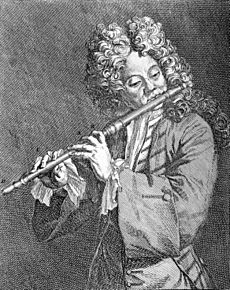Jacques-Martin Hotteterre facts for kids
Jacques-Martin Hotteterre (born September 29, 1673 – died July 16, 1763) was a famous French composer and flautist. He was the most well-known member of a family that made and played wind instruments. People also knew him as Jacques Martin or Jacques Hotteterre.
Contents
About His Life
Jacques-Martin Hotteterre was born in Paris, France. His father was Martin Hotteterre. Around 1704, Jacques-Martin took over a job at the royal court. He played the oboe and violin there.
Early in his career, Hotteterre lived and studied in Rome, Italy. This is why he got the nickname le Romain, which means "the Roman." He worked for Prince Francesco Ruspoli in Rome for two years. By 1708, he became a musician for the King of France. He was part of a special group called the King's Grande Écurie. In 1717, he got another important job. He became the "Flute Player for the Chamber Music" of the King.
Hotteterre was very famous because he was an amazing flute player. He wrote many new pieces for the flute, which made the instrument's music collection much bigger. He also played the bassoon, oboe, and musette (a type of bagpipe). Hotteterre was also a well-known teacher to rich and important people from different countries.
He wrote several "how-to" guides for playing instruments. In 1707, he published a guide for the transverse flute, recorder, and oboe. In 1737, he published a guide for the musette. His book L'Art de préluder sur la flûte traversière came out in 1719. This was the first instruction book for the flute in Europe and was used widely.
Over the years, some transverse flutes have been found with "HOTTETERRE" and an anchor symbol on them. These flutes show what the Hotteterre family created. Experts know of three "Hotteterre" flutes in Berlin, St. Petersburg, and Graz. However, it was recently found that two of these are copies made much later. Only the flute in Graz is truly from Jacques Hotteterre or his father, Martin.
Besides playing and teaching, Hotteterre continued his family's tradition of making wind instruments. He might have been the one who made changes to how the transverse flute was designed. Before, the flute was made in one long, straight piece. He helped change it so it was made in three parts: the head (where you blow), the body (with most of the holes), and the foot (with one key for a low note).
Many other members of the Hotteterre family were also great woodwind players. Some of them also made big changes to how woodwind instruments were built. Jacques's grandfather, Jean (who lived from about 1605 to 1690–1692), was known for his playing and new ideas in instrument making. He is often said to have created the oboe. Jean and his son Martin (Jacques-Martin's father) made important improvements to the musette. Some recorders made by the Hotteterre family still exist today, but none are thought to be by Jacques-Martin himself.
Jacques-Martin Hotteterre passed away in Paris in 1763.
His Music and Books
Here are some of the works Jacques-Martin Hotteterre created:
- Op. 1 Principes de la flûte traversière, ou flûte d'Allemangne, de la flûte à bec ou flûte douce et du hautbois, divisez par traictez (1707) – This was his instruction book for flutes and oboe.
- Op. 2 Premier livre de pièces pour la flûte traversière et autres instruments avec la basse (1708) – His first book of pieces for flute and other instruments.
- Op. 3 Sonates en trio pour les flûtes traversières et a bec, violon, hautbois (1712) – Sonatas for three instruments like flutes, violin, and oboe.
- Op. 4 Première suitte de pièces suite de pièces à deux dessus, sans basse continue. Pour les flûtes-traversières, flûtes à bec, violes, " (1712) – First set of pieces for two instruments without a bass part.
- Op. 5 Deuxième livre de pièces pour la flûte traversière et autres instruments avec la basse (1715) – His second book of pieces for flute and other instruments.
- Op. 6 Deuxième suite de pièces à deux dessus pour les flûtes-traversières, flûtes à bec, violes, etc... avec une basse adjoutée et sans altération des dessus, laquelle on y pourra joindre pour le concert" (1717) – Second set of pieces for two instruments, with an added bass part.
- Op. 7 L'art de Préluder (1719) – His famous book about how to play preludes (short musical pieces).
- Op. 8 Troisième suite de pièces à deux dessus (1722) – Third set of pieces for two instruments.
- Op. 9 Concert de Rossignol (lost) – A concert piece that is now missing.
- Op. 10 Méthode pour la Musette contenant des principes, par un recueil d'airs et quelques préludes (1738) – His instruction book for the musette.
- Airs et brunettes à deux et trois dessus avec la basse – Tirez des meilleurs autheurs (1721) – A collection of songs and tunes.
- Arrangements of pieces by Valentine and Torelli for two flutes.
- Arrangement of trios by Albinoni (lost).
Media
See also
 In Spanish: Jacques-Martin Hotteterre para niños
In Spanish: Jacques-Martin Hotteterre para niños


